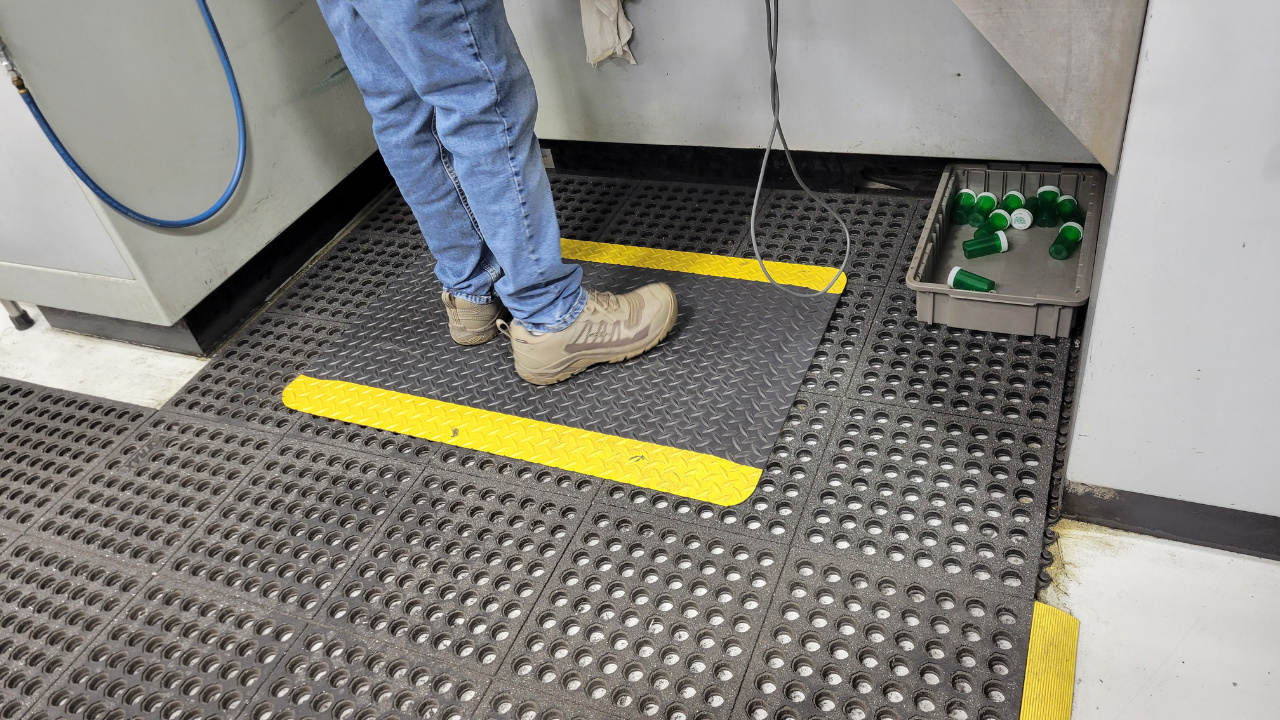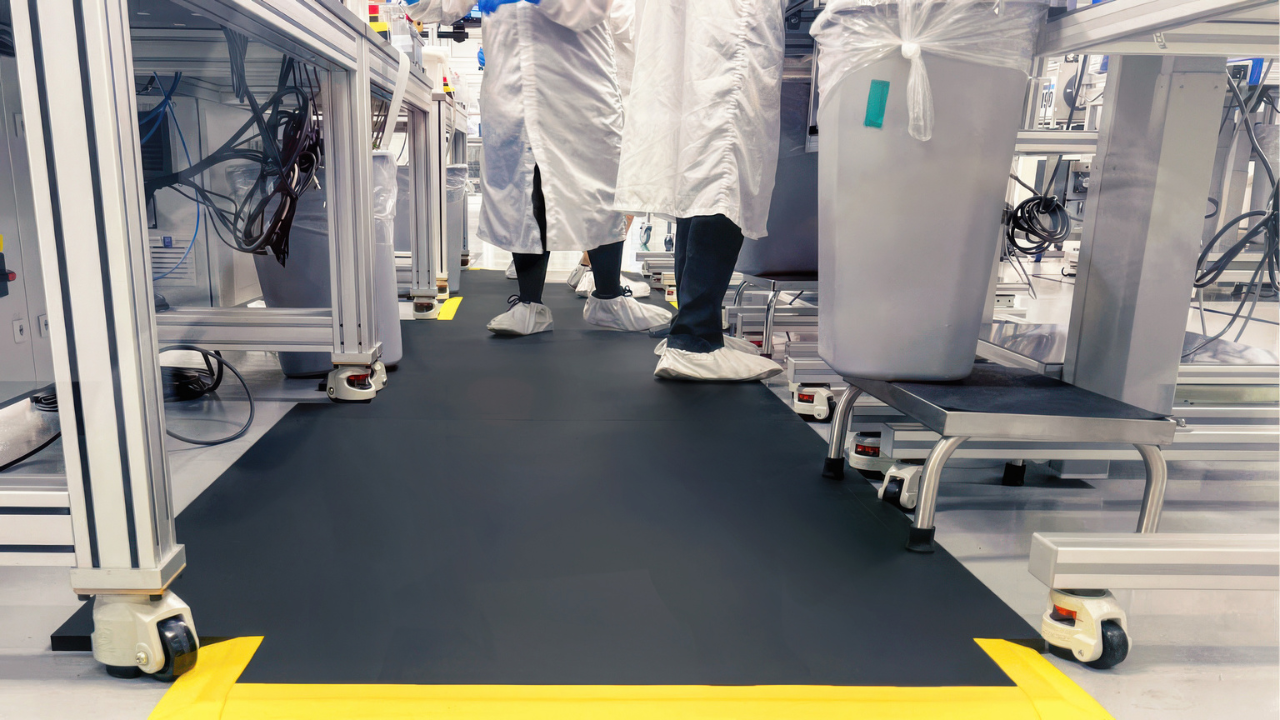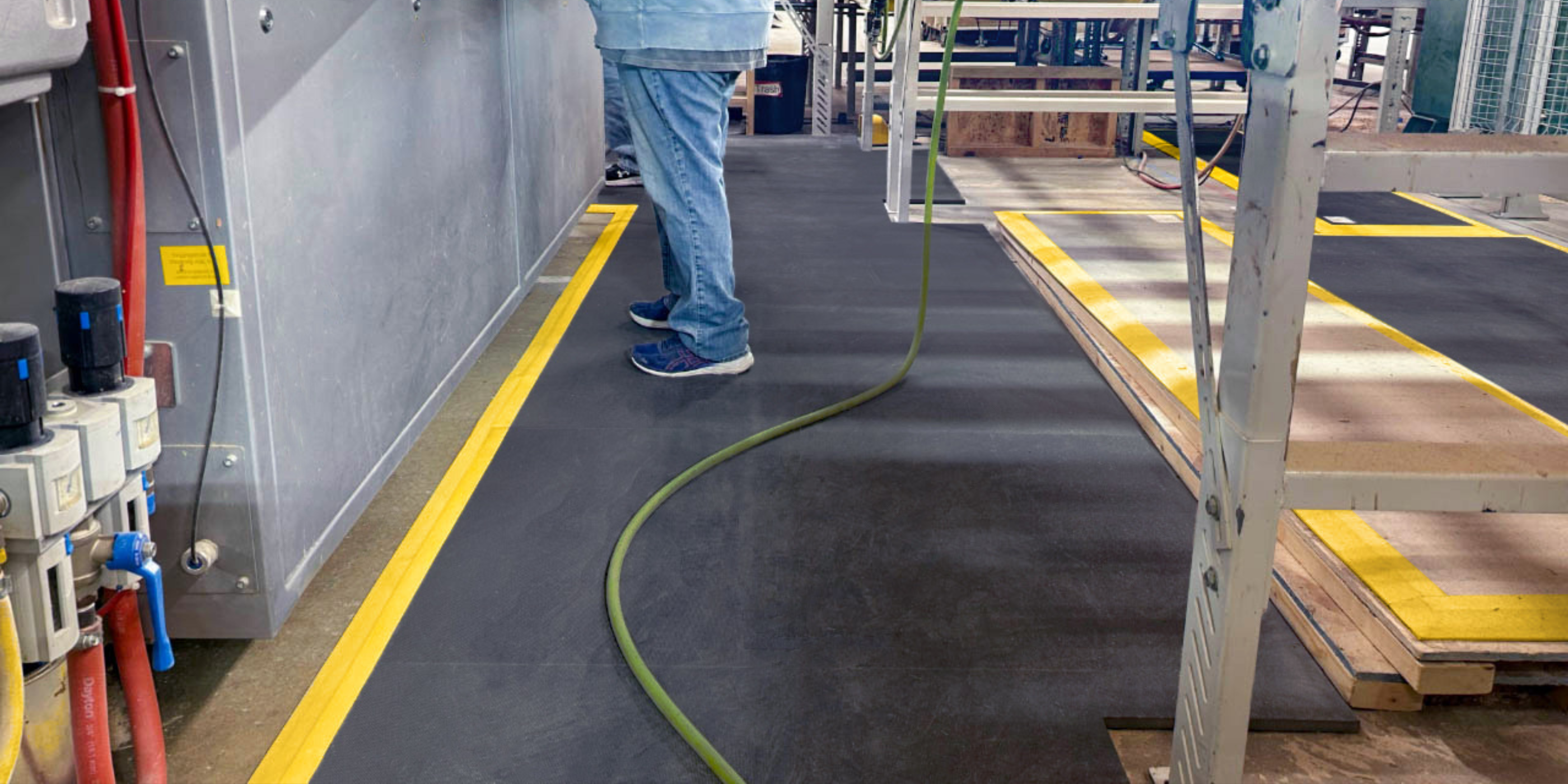AcroMat has provided over 300 anti-fatigue mat inspections over the past year, and during these reviews we've seen a concerning practice emerge – standing workers are stacking their anti-fatigue mats with the belief it is creating additional support. In fact, over 40% of the 200+ safety, production and manufacturing leaders we surveyed between 2023-2024 say they are finding stacked mats in their manufacturing facilities.
While stacking may seem to be a helpful response to discomfort, in reality it's likely increasing the risk of MSD injuries along with slips, trips, and falls.
Why Do Users Stack Their Mats?
Stacking consists of placing one or more mats on top of another to create additional cushion. In short, this causes postural instability, puts added pressure on the ankles, and increases the risk of tripping by creating an uneven surface.
Stacking occurs for two reasons. First, when mats lose their anti-fatigue properties employees will stack old mats to compensate for the lost cushion. Second, if you invest in low-quality mats that lack enough cushion, something we often see with tiles, employees often feel the need to stack multiple mats to create a more comfortable standing surface.
Below, 3 hidden dangers of stacking your anti-fatigue mats – including insight from Certified Professional Ergonomist, Occupational Therapist and Owner of OptimaEHS, Mary Plehal, and Board Certified Ergonomist and Owner of ergonomicsHelp, Darcie Jaremey.

"Stacked mats creates postural instability that causes the feet, ankles and upwards to the lower back to have to make constant micro-adjustments to maintain balance. This is similar to working in high heels day after day," says Ergonomist Mary Plehal.
1. Uneven Standing Surfaces
"It's common for stacked mats to be different sizes, heights and products which creates uneven standing surfaces," says Mary. "This is awkward and exposes employees to a higher risk of slips, trips, falls, and rolled ankles."
According to the National Safety Council (NSC), slips, trips and falls are the No. 2 most common workplace injury. The average trip and fall injuries costs nearly $50,000 and 12 missed days of work per injury. However, also according to NSC, slips, trips and falls are the No. 1 most preventable workplace injury.
Locating, removing, and replacing stacked anti-fatigue mats is an immediate and simple step you can take towards injury prevention.

According to Mary, standing on stacked mats is comparable to working in high heels day after day. For employees who are on their feet for 8-10 hours every shift, the risk if injury is high.
2. Postural Instability
"The biggest concern from an ergonomic point of view is that double-stacked mats may seem to have subjectively more cushion which is perceived as a good thing," says Mary. "In reality, it creates postural instability that causes the feet, ankles and upwards to the lower back to have to make constant micro-adjustments to maintain balance. This is similar to working in high heels day after day."
Over time, this constant need for readjustment leads to discomfort, fatigue, and even chronic musculoskeletal (MSD) issues that employees may fail to associate with the mats themselves. According to the Occupational Safety and Health Administration, MSDs are the leading cause of absenteeism in manufacturing – costing companies more then $3 billion every year.

Made from molded, closed cell, 100% nitrile rubber foam, the AcroMat 100-1 Series, 100-Cleanroom Series (pictured above), and 100-ESD Series mats are guaranteed to never sink, flatten, or lose their ergonomic cushion. The medium-soft cushion you begin with remains intact from standing use for as long as the mat is in place.
Related: 6 Ways Nitrile Mats Reduce Pain & Discomfort
3. Absenteeism and Turnover
Employees who stack their mats are doing so for a reason – they don’t think the mats are providing enough cushion or support. This discomfort and fatigue can lead to disengagement and higher turnover.
According to Emerald Technologies, "Dreary workplaces can increase stress levels and reduce productivity. Conversely, aesthetically pleasing interiors reduce stress."
Psychology Today adds, "Workplace design has a profound influence on an employee's cognition and mental well-being."
Neglecting to address stacked mats not only compromises health and safety, but can also impact engagement, productivity, recruitment, and turnover.

Board Certified Professional Ergonomist, Darcie Jaremey, recently reviewed AcroMat's 100-Series anti-fatigue mats. Read review.
Summary: Invest and Educate
"Double-stacking your anti-fatigue mats may seem like a quick fix for worn-out or inadequate mats, but its dangers can't be ignored," concludes Mary. "Uneven surfaces, awkward step-offs, postural instability, discomfort, and long-term health implications are just a few of the risks."
MSD injuries, combined with slips, trips and falls, account for nearly 50% of all workplace injuries. You can make sure your floors are working toward prevention by rooting out stacked anti-fatigue mats and replacing them with mats that never lose their cushion.

According to Mary, there is "no need to double-stack AcroMat anti-fatigue mats."
Kickstart your efforts by comparing AcroMat to the anti-fatigue mat you use now. Experience the difference of anti-fatigue mats that are guaranteed to never sink, flatten, or lose their ergonomic cushion:




